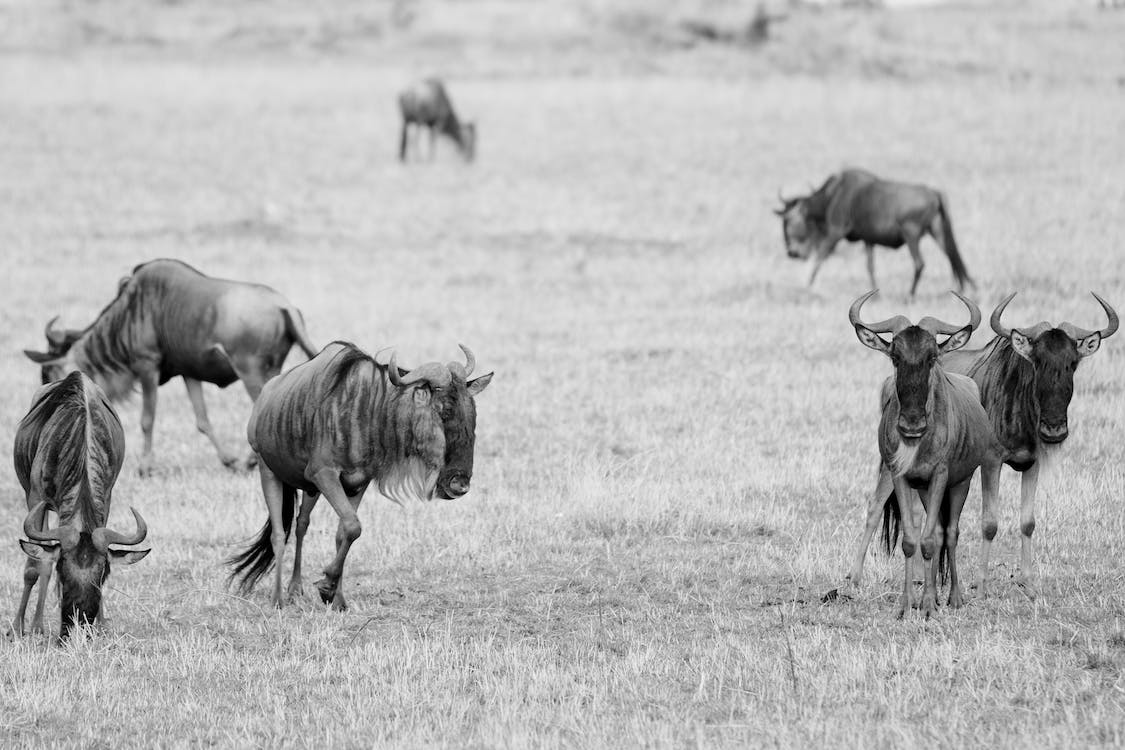The Black Wildebeest is a huge mammal mainly found in the southern region of Africa. Its population faced a dark history, for it once stood on the brink of extinction. Presently, their population is thriving; and this would not be possible without humanity’s collective effort in saving their species.
Read further to know more about the Black Wildebeest.
What is a Black Wildebeest?
Endemic to the southern region of the African continent, the Black Wildebeest (or also known as the Connochaetes gnou) is categorized under the genus Connochaetes and family Bovidae. This mammal was first defined in 1780 by German geographer and zoologist Eberhard August Wilhelm von Zimmermann. It is characterized by its long, sturdy horns, white horse-like tail, and black head.
A glance about its history: the population of Black Wildebeest in the southern African region faced near extinction during the 19th century because of their reputation as pests. Only an average of 600 individuals have survived. Back in the day, they inhabited northern South Africa, western Lesotho, western Swaziland, and the grassland savannas of the Drakensberg in KwaZulu-Natal in South Africa. To increase their number, they were reintroduced to other parts of neighboring countries such as Namibia, Kenya, and Swaziland (Eswatini).
Now that the population is in a continuous rise, the International Union for Conservation of Nature (IUCN) categorized this species as “Least Concern.”
Its eight levels of scientific classification are as follows:
Kingdom: Animalia
Phylum: Chordata
Class: Mammalia
Order: Artiodactyla
Family: Bovidae
Subfamily: Alcelaphinae
Genus: Connochaetes
Species: C. gnou
Physical description of a Black Wildebeest
A Black Wildebeest can be easily recognizable due to their distinct features: its long white tail that remarkably resembles that of a horse’s, hence its nickname “white-tailed gnu.” It is darkish brown or black in color, a male Black Wildebeest being relatively darker than a female one. During summertime, both male and female Black Wildebeests become lighter in color coats. During the winter season, they grow shaggier and heavy coats.
Like a common wildebeest, the Black Wildebeest possesses a whitish mane that protrudes from its neck. It has a beard that ends in the lower jaw. Its head-and-body length varies from 170 to 220 cm. A male Black Wildebeest usually weighs 140 to 157 kg, while a female weighs 110 to 122 kg.
In addition, a Black Wildebeest has dark hairs between its forelegs that cover its chest. It has long, sturdy horns that are initially straight, but the horns widen, curve, and flatten as they age to serve as their shield from predators.
Black Wildebeest’s distribution and habitat
Black Wildebeests are commonly found in the southern region of the African continent, mainly in South Africa. They prefer habitats that are open and vast, like open plains, grasslands, shrublands, arid Karoo region, and grass fields. Since they are grazers, they avoid habitats with tall grass and dense foliage. More often than not, Black Wildebeests are seen in the same habitat as Blesboks and Springboks.
How do Black Wildebeests behave?
A Black Wildebeest can be found in three types of herds. The first one consists of territorial bulls. The herd’s ultimate goal is to attract female Black Wildebeests. Secondly, a group of female Black Wildebeests with at least one dominant bull and their offspring. Lastly, a herd that consists of bachelor Black Wildebeests.
Dominant bulls can be found in every type of herd. Usually, older Black Wildebeests are excluded from these types of herd. The largest herd ever recorded has at least 330 Black Wildebeests, and this can be found at Willem Pretorius Game Reserve, Orange Free State, South Africa.
Unlike common Wildebeests, Black Wildebeests do not groom each other and rub their foreheads with others of their kind. However, sometimes, a Black Wildebeest rubs its cheeks on its companion’s neck.
A calf stays close with its mother until it gives birth to another calf. There are instances when calves are separated from their mothers because adult male bulls eliminate them from the herd. As a result, these evicted calves form bachelor herds to protect themselves together.
More fascinating facts about the Black Wildebeest
Black Wildebeests are herbivores who feed on bushes, leaves, shrubs, flowers, stems, and wood.
Consequently, they play an essential role in the ecosystem. They serve as important prey for large predators such as lions, cheetahs, and hyenas.
In humanity’s lens, this species brings both positive and negative impacts. They bring joy to tourists when they visit wildlife parks and safaris.
However, they are carriers of bovine diseases and parasites that may be harmful to human life.
SOUTH AFRICAWILDLIFE PARKS AND RESERVES WHERE THIS SPECIES IS FOUND:
